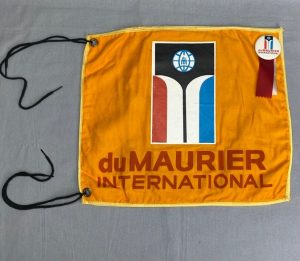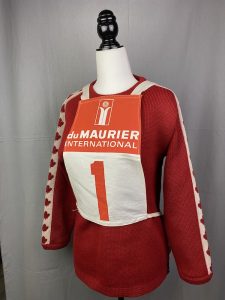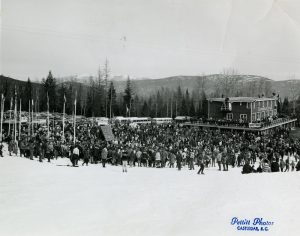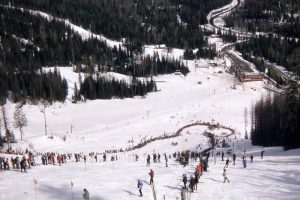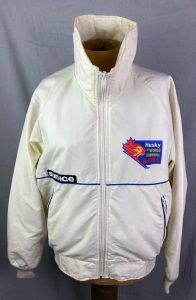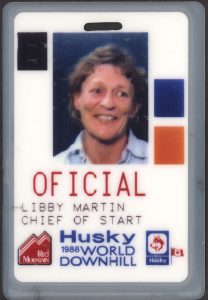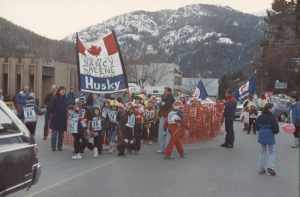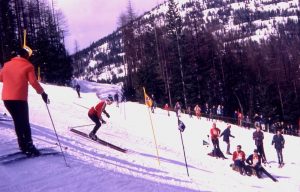The World Cup Comes to Rossland
1968 du Maurier International World Cup
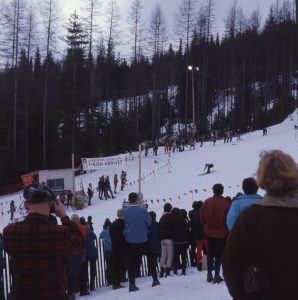
Spectators watching a racer approaching the finish line of a race at the 1968 du Maurier International World Cup
On March 28-31, 1968, Rossland made history by hosting the first World Cup event held in Canada. This opportunity was a major deal. Previously, Canadians had limited international exposure at home despite the growing success of the racers. Canada’s first attempt at hosting an international competition arrived in 1966. Imperial Tobacco Limited and the Canadian Amateur Ski Association (CASA) supported an International Ski Federation (FIS) sanctioned ski meet called the du Maurier International. The following year the organizations supported another ski meet. These successful competitions laid the foundation for FIS to include the du Maurier International as a World Cup event. In doing so, this put Canada on the map for alpine skiing.
Marc Hodler, president of Federation International de Ski, “welcomed Canada” as another step in the growth of the sport. It is fitting Canada is part of the World Cup after Nancy Greene’s great win last season.
– Rossland Miner, September 28, 1967
Monumentally, CASA selected Red Mountain after the joint presentation by the City of Trail and the Rossland Chamber of Commerce. This tournament was the second-to-last event in the World Cup circuit. It consisted of slalom and giant slalom races for both men and women. Rossland also held a banquet for competitors and coaches, a parade, and other Sno-Sho (Winter Carnival) festivities to keep visitors entertained during their stay. Overall, the du Maurier brought approximately 130 (75 men and 55 women) of the world’s best skiers to Rossland, plus coaches, spectators, and international media. Over 7,000 spectators lined the course to watch the competitors dominate the hill. Excitingly, Nancy Greene, in front of her hometown, scored enough points to secure the 1968 World Championship title, even with one more World Cup race to go.
To pull off an event of this size, the Red Mountain Ski Club (RMSC) utilized much of their prior experience hosting large-scale tournaments, including the Canadian Championships in 1966 and 1967. They mobilized over 600 volunteers to ensure the events had gatekeepers, timekeepers, forerunners, etc. The RMSC also worked with the entire town and neighbouring communities to prepare for the number of guests arriving. Volunteers organized accommodations from Grand Forks to Nelson in hotels and motels as well as local billets. They also ensured that there was enough food available for visitors by organizing commercial catering facilities, cafes, and restaurants. Overall, the event was very successful! They were even praised for how quickly the organizers could post the results with modern timing technology from Cominco Ltd. (previously known as the Consolidated Mining & Smelting Company of Canada Limited).
Husky Women’s World Cup
Rossland got another opportunity to host a World Cup event in 1988. Officially held on March 12 and 13 and sponsored by Husky Oil, this competition was for the women’s downhill and super G events. Tom Johnston, Don Mousseau, Robin Valentine, and Bob Dunsdon spearheaded the bid for Red Mountain to host a 1988 World Cup event. The community heavily supported this bid. The City of Rossland and Castlegar Chamber of Commerce provided support letters for their proposal. Representatives from the Red Mountain Racers (RMR), RMSC, local governments, businesses, and industries came together to form the Red Mountain-Columbia Valley Foundation. These local businesses and industries included representatives from major local companies including Cominco Ltd., West Kootenay Power & Light Co., Celgar Ltd., as well as the Regional District of Kootenay Boundary. They worked with hundreds of volunteers to organize a professionally-run event and show the world that the Red Mountain Ski Area was comparable to other international sites. Ultimately, they were very successful and praised for the volunteer-spirit that was infused in the event.
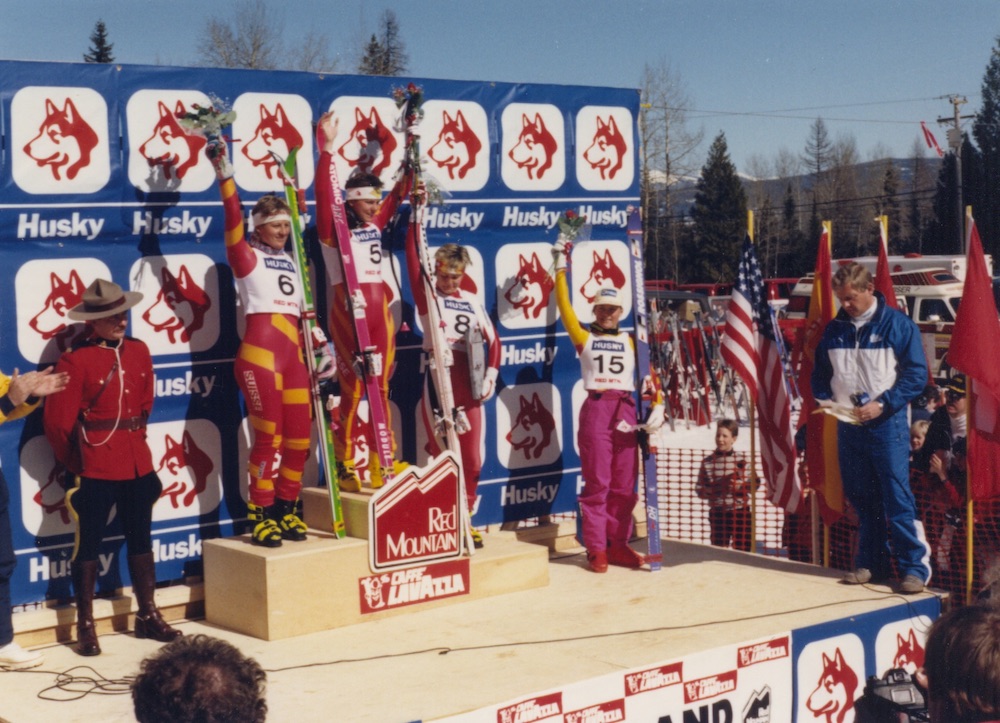
Medal Ceremony at the 1988 Husky Downhill World Cup. Women left to right: Brigitte Oertli (Switzerland), Michela Figini (Switzerland), Veronika Wallinger (Austria), Karen Percy (Canada)
Impact: Local competitors, Red Mountain Racers, and the Community
Hosting these two major events was impactful for community members and RMR for various reasons. For local National Team members, it was an opportunity to race at an international event in front of a hometown crowd. Kerrin Lee recounts the support she felt competing in the Husky Women’s World Cup:
I don’t feel any extra pressure. I think it is encouragement. I think it helps me out and everybody here is so supportive it’s incredible. For all Canadians they’re supportive. They’re such nice people. It’s good to come back home and have somebody behind you.
– Kerrin Lee, Trail Times Daily, March 11, 1988
The du Maurier International and the Husky Cup were also hugely inspirational for all RMR. Many aspiring younger skiers got to watch an international event for the first time and saw their heroes ski the slopes they grew up skiing. Additionally, they got to participate in preparing for a significant world ski event. As such, determined skiers could visualize a path to the top. Finally, for the ski club members and volunteers, there was a sense of pride in successfully hosting World Cup events in such a small community. They sought to prove Red Mountain’s suitability as a venue for international competitions after not being chosen in 1960 for Canada’s 1968 Olympic bid. After holding two world cup events, no one could deny that Red Mountain was a world class ski area!
Former volunteers and Red Mountain Racers recall their experiences hosting and participating in these championship races at Red Mountain (captions available in both EN and FR). View this video with a transcript (EN).
Note: Libby Martin was a “hand timer” at the Canadian Nationals, but there was also electronic timing. Hand timing was a backup for electronic timing.


